Tuesday, October 27
Thank Goodness Verdi Stuck to Requiems
Thinking about the Verdi Requiem got me thinking: What if Verdi had written a Mass? I'm assuming it would have the following plot:
The Priest is a hunchback who mentors the subdeacon, a seminarian, with a shady past and unknown origins. We discover all this by the Kyrie. The graduale is the hit chant "La Nonna Immobile" [in honor of a particularly ferociously stolid Italian churchlady, no doubt. --MGA] By the time we get to the Credo we learn that the subdeacon is actually the schola director in disguise, as the two happen to be identical twins. Confusion ensues, but is merrily resolved. At the Sanctus we discover that the priest and the deacon were switched at ordination (Two hunchbacks--Take that, Rigoletto!), and a fight breaks out at the first step (see Fortescue, p. 47 for the staging of said fight). By the Agnus Dei the deacon has killed the priest (thurible fight!), and repeats the prayer of consecration to make the Mass valid. While he says the prayers, the subdeacon and schola director join in in perfect counterpoint. The people receive communion and the Mass concludes with "Ah! Ah! La Benedictio-oh-ne!" The sacred ministers recess.
And it's all staged by Zeffirelli, with costumes by Wippel. Like the Mass will be in heaven.
Monday, October 26
Christus Rex Redux
Now you know!
We have commanded its observance on a Sunday in order that not only the clergy may perform their duty by saying Mass and reciting the Office, but that the laity too, free from their daily tasks, may in a spirit of holy joy give ample testimony of their obedience and subjection to Christ. The last Sunday of October seemed the most convenient of all for this purpose, because it is at the end of the liturgical year, and thus the feast of the Kingship of Christ sets the crowning glory upon the mysteries of the life of Christ already commemorated during the year, and, before celebrating the triumph of all the Saints, we proclaim and extol the glory of him who triumphs in all the Saints and in all the Elect.
Dappled Things Achieves the High Water Mark of the Real Ultimate Power Meme
And now, Catholic litterateurs. Everyone's favorite literary shogun, Bernardo, writes:
Hi, this message is all about
Facts:
1. Dappled Things is made by mammals. Rational mammals.
2. Dappled Things is awesome ALL the time.
3. The purpose of Dappled Things is to flip out and kill bad writing.
The new issue’s weapons and gear:
1. Fiction by best-selling science fiction writer John C. Wright, as well as an interview with him that you will LOVE—if you know what’s good for you. “Oh, what’s the big deal?” you foolishly ask. Fine, I’ll give you a sample. But if you don’t like it, there’s no hope for you, and you need to go away and read some Dan Brown. Here is a totally sweet passage:
I first noticed the angel across the platform when I went in to buy my ticket. Admittedly, the sight made me nervous. I nonchalantly tried to keep him in view and I even bought a newspaper so I could hide my face while staring, just like a spy in a bad sitcom.
2. Killer stories by Tony France, Fiorella de Maria, and Gerald C. Matics.
3.
4. Essays that will explode your brain with their awesomeness, like Michael L. Ortiz’s “Some Remarks on Autism and Catholicism” or the second part of Eileen Cunis’s “On the Vocation of the Christian Artist.” In his sweet essay, Mr. Ortiz, who has Asperger Syndrome, gives us a window into his mind:
The first thing that some people notice upon meeting me is that I do not make eye contact. This is not because I am shy or devious; eye contact simply overloads my senses and makes me unable to think. To me, eyes are like the sun, which blinds by its excess of light. Furthermore, faces refuse to resolve themselves into recognizable composites for me: they remain mere assortments of features. . . . Sometimes I fail to recognize acquaintances, and sometimes I mistake strangers for friends. I once recognized my wife’s nose from a distance -in a crowded public place, well before I realized that my wife was attached to
it.
If you don’t think that sounds like a TOTALLY COOL essay, then go away and sit at the loser’s table, ’cause you obviously don’t have a clue.
5. Poetry and art so absurdly strong that they’ll leave you weeping like a little girl. Yeah, that’s right. Run to Mommy.
The new issue is so crazy and awesome that it flips out ALL the time. I heard that there was a copy of the new issue that was eating at a diner. And when some dude split an infinitive, the copy killed the whole town. (Metaphorically.) My friend said that he saw a copy totally uppercut some kid just because he didn’t understand that beauty is the enjoyment that comes from the contemplation of being.
And that’s what I call
If you don’t believe that the new issue of Dappled Things has
Also, the new issue (and every issue) is soooo sweet that you need to
Q and A:
Q: Why is everyone so obsessed about Dappled Things?
A: Dappled Things is the ultimate paradox. On the one hand, it doesn’t care for the fads and fallacies of contemporary culture, but on the other hand, it’s at the cutting edge.
Q: I heard that
A: Whoever told you that is a total liar. Just like other mammals who love good writing, the editors can be mean OR totally awesome.
Q: What do issues of Dappled Things do when they’re not killing fallacies or flipping out?
A: Most of their free time is spent flying, but sometimes they build cathedrals. (Ask Matthew Alderman if you don’t believe me.)
If you are ready for
* Editor-in-Chief’s Note: The hardworking, fun-loving, and (figuratively) nunchaku-wielding staff of Dappled Things takes no responsibility for injuries incurred by a too literal reading of the comparison of utterly awesome literary writing’s effect on the mind to that of ninjas on the body. Any resemblance to actual ninjas, living or dead, is purely coincidental.
Sunday, October 25
From This Day Until the Ending of the World
I am somewhat less of an Anglophile than I used to be growing up, having discovered the rich and occasionally bittersweet world of old Spain and the charming, courtly fatalism of the geographical mess that was once Hapsburg Austria, but there still is much to recommend Old Blighty--at least before it is legislated out of existence by Brussels--and all of it is represented perfectly in miniature in this little clip. (We will overlook the fact that had England hung onto her French lands, France might not now be a Catholic nation, as opposed to today where it is a vibrantly...um... Er. Um. Long awkward pause. Okay, maybe it didn't matter that much after all. Apologies, Joanie, you did your best.)
This speech, and Olivier's masterful (and at times highly stylized) film of Shakespeare's Henry V was a huge formative influence in my childhood--with all its knights, chivalry, pomp, and star-sunbursted black armor, set against a background borrowed wholesale from the Hours of the Duke of Berry--and I was blessed to have parents who thought to put such things in my way. (And then there were some bits that just baffled me, like Falstaff's death.) I had seen it so many times that, when we were called to memorize and recite a monologue from Shakespeare years later in high school it was fairly easy for me to simply brush off Henry's rousing speech before Agincourt with a minimum of fuss.
Incidentally, Sts. Crispin and Crispinian were twin preachers who moonlighted (elves-and-shoemaker-style) as cobblers, eventually getting martyred in Soissons circa 286. They are patrons of all those who work with leather, among other things. Naturally, some tiresome persons have suggested they are the result of Christianizing some local fertility cult, I suppose, because it would seem to some people that's how saints are apparently made, not because some good Christians had the courage to go out and die for their beliefs. Imagine that.
Today, in the 1962 calendar, is the Feast of Christ the King. I love the old calendar a lot, with its various ranks of feasts and its octaves (even if some of those were suppressed from the still older 1952 calendar), but I am mystified why our celebration of Christ's very real rulership over the earth and His paramount place in our society and homes, is stuck at the end of October. But liturgy is not about a priori logic, so I can let it slide. Maybe it has something to do with the October Revolution or something. But the intersection of Christus Rex and Crispin Crispian is an apt one this year, given the wonderful rah-rah nature of this feast's collects, which shine out in our embattled age just as brightly as Henry's speech before Agincourt:
We have received the food of immortality and beg, Lord,Naturally, at my local ICRSP oratory, we had quite a blowout, the first solemn high mass I have seen since our pilgrimage out to Holy Hill, and the choir (in the words of friend Matt N.) rocked the Christus Vincit complete with an abbreviated version of the Laudes Regiae, that old papal litany of saints with the wonderful repetition of Tu illam adjuva. Viva Cristo Rey!
that we who are proud to fight under the banner of Christ our King,
may reign with Him for ever in His realm above.
Saturday, October 24
They Told Me That They Insisted My Name Be in Bigger Type than the Words 'Free Beer'

Come one! Come all! I'll be speaking at the Essen Haus in beautiful downtown Madison next Thursday, October 29, at 7 PM. Thrill to the Spirit of the Liturgy! Be introduced to the mysterious practices of Early Christian architecture! Boo and Hiss at the villainous architectural modernist Sovik the Destroyer! See some of the author's latest work! And there may even be a few jokes at the expense of disco and 1970s architecture!
Christ the King, La Crosse (No, Not that One, the Other One)

It appears I am not the only person to design a seminary chapel dedicated to Our Lord's kingship in La Crosse, Wisconsin. (For those of you entering this in progress, my thesis project was a hypothetical American seminary for our friends over at the Institute, sited on a very real location east of the city, nestled amid the bluffs.) The former seminary chapel--now the diocesan chancery's--is dedicated under that title as well, and is a real (if highly unusual) gem. It is the work of the twentieth century's most underrated liturgical architect, the great and miraculously versatile Edward J. Schulte.

Schulte was a Cincinnati-based designer, and his enormously long career in the field started after an encounter with Ralph Adams Cram at the start of the century and closed in 1967, his death coming only a few years later in 1975. Schulte's great strength was his ability to design traditional churches with a modern flair, and embody even his more austere, modernistic designs (depending on the client) with an unparalelled sense of groundedness, liturgical decorum and beauty. [Some of his later work was admittedly uneven, as I was recently told his son did a good deal of the late-in-life work attributed to him, due to ill-health, but at the very least, there are interesting aspects to it.] There is shockingly little about him in print, save for a few scattered references and unpublished dissertations, but with the growing interest in the architects of that era, perhaps this will change.
Schulte also designed the impressive (and, at its completion at 1962, surprisingly new) cathedral in La Crosse, which I will cover in a future post. It deals with many of the same decorative and iconographic themes as the chapel, but in a much-enlarged way. It would be interesting to see which came first.
Here follow a few more photos of the interior, taken on a recent visit to the area. Fellow blogger and friend Br. Stephen of Spring Bank (who joined me on my tour of sacred La Crosse this time) has also covered this chapel at his site as well.

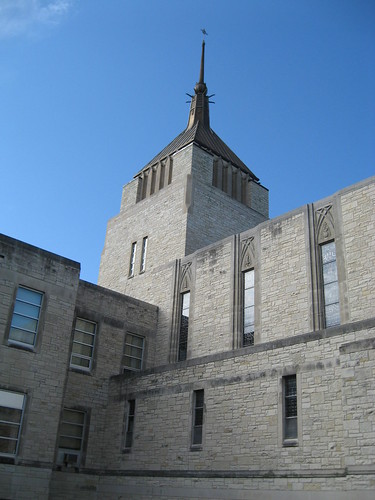
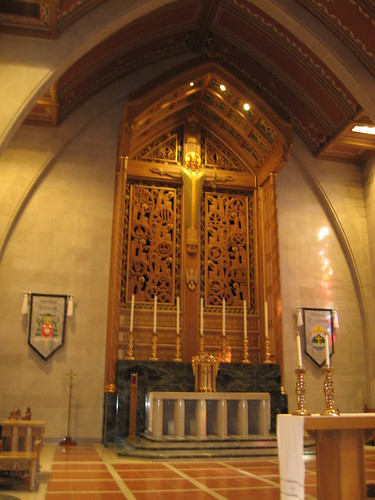
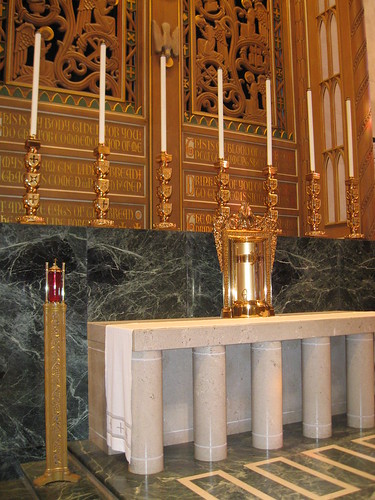
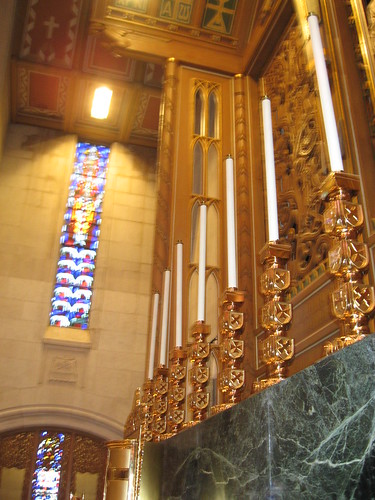
Saturday, October 17

"Let not the Trojans keep you at arm's length, Achaeans, but go for them and fight them man for man. ... so far as in me lies I will show no slackness of hand or foot nor want of endurance, not even for a moment; I will utterly break their ranks, and woe to the Trojan who shall venture within reach of my spear." -Iliad, Book XX
Friday, October 16
Architectural Counter-Proposals by the Author
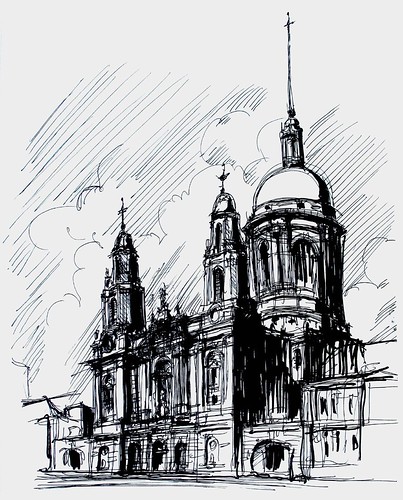
For our new readers, here's another good introduction to my work and design philosophy. I frequently undertake designs for counter-proposals to existing churches and cathedrals to help illustrate and develop my architectural and liturgical philosophy. The inimitable Cusack has a whole category devoted to them over at his website here.
An Architectural Capriccio from the Author's Sketchbook
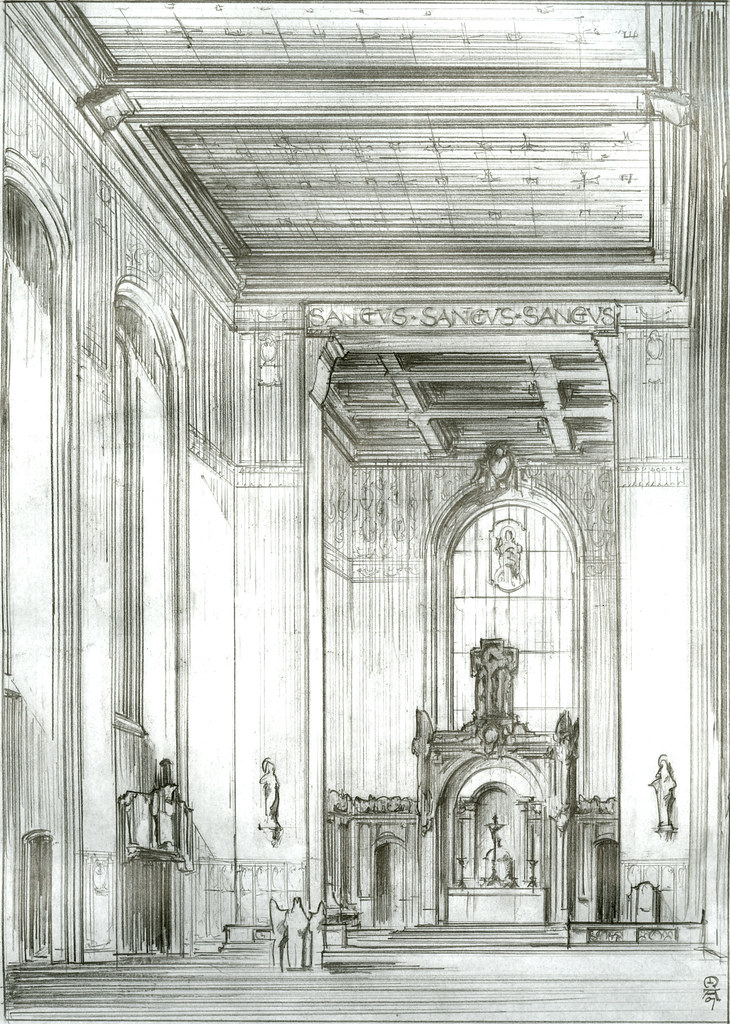
Sketch for an Ideal Parish, featured in "Incarnating the Mass," St. Austin Review, May/June 2007 and in "Heaven Made Manifest," the 2008 volume of Antiphon, the Journal of the Society for Catholic Liturgy.
Note the simplicity of the volume and the prominence of the altar--showing what can be achieved on a budget with simple proportions, strategic ornamentation, and a logical sense of liturgical planning.
Welcome, Radiolanders!
While, through the firm I work for, I am soon to be involved in at least one traditional sacred architecture design (more on that in the future), I recently saw the completion of much of my furnishing designs for the newly-restored historic Catholic cathedral in Vladivostok, Russia, Most Holy Mother of God Catholic Church. You can find photographs of it at the Vladivostok mission's website, and I hope to post on it in the near future.
Thursday, October 15
Matthew Alderman on ETWN Radio Tomorrow
Anyway, our readers will be interested to hear I will be interviewed tomorrow by producer Matt Swaim on the Sonrise Morning Show on EWTN Radio at around 8:10 AM EST (7:10 CST). I will be discussing the relationship between liturgy and architecture in general and specifically in my own work and writing. EWTN Radio is based in Cincinnati, Ohio, and if there is not a local affiliate near where you live, you can tune in via the internet at sacredheartradio.com.
Monday, October 5
Cistercian Comedy
"That sign language was abused is not in doubt. It is not difficult to create new signs for new circumstances, and the various proscriptions issued at various times by the General Chapter make it abundantly clear that sign language was also being used for joking and idle conversation. The repetition of these proscriptions would also seem to indicate that the views of the General Chapter were not always heeded."
--Terryl N. Kinder, Cistercian Europe: Architecture of Contemplation, p. 59
Sunday, October 4
On Prayer
I am not good at praying. No, scratch that. I am not good at Prayer with a capital P. Unlike Talleyrand, and like Vivaldi, I at least give it a good college try. My mind wanders, and I sit up in the choirloft trying very hard not to redesign the church or work out this week's correspondence in my head during the Canon. (And yes, I am in a chant schola, which is great fun though more than a little alarming as I cannot read sheet music. The idea is to shove me between two baritones and hope for the best.) This is probably why I enjoyed altar serving so much, because at the very least it gave me something to do, and that, too, is a prayer. Having hung up my cassock pretty much permanently since my move to Milwaukee, it requires something to fill the void. The singing helps a lot.
At the very least, though, with my rosaries and masses shot full of little distracted holes (it once took me 45 minutes to say a rosary on my own since I kept getting off-topic), I am used to thinking of prayer as a sort of sacrifice of time, especially given my perpetual tendency to keep myself busy, for better or worse. And that was enough for me. God wanted to me to do it and I know from long experience He knows what he's doing.
But then I heard something really fascinating the other day from a friend. It was at a young adults' Q-and-A session, and prayer came up, the usual thing about whether we're changing God's mind, and all that good stuff. Given God exists outside time, that whole connundrum doesn't bother me that much. But why exactly we have to ask for something we're going to get anyway, does. One can simply chalk it up to an exercise in humility, or a sort of continual remembrance of God's gifts, or the worship due to the Creator. That was good enough for me, though on some level it never quite satisfied. But then, my friend Peter A--, who was answering the questions that night, made the point that not only did God know you were going to say that prayer from all eternity, it was specifically part of His plan you would, however great or small it was. It was not just a matter of you having to humbly ask for what you would receive anyway but that God was letting you, little tiny insignificant you--play that special role within history. God wanted you to say that prayer. And it's the same with the saints. God is making their intercession part of the plan of history as well. It is a humbling act, but prayer is thus also God letting us help out in some mysterious way. Admitted, it's a bit like when a little kid sitting in the baby seat of a bicycle "pushes" his father uphill, but it's still a pretty powerful idea, that God would want to let us use our free will to bring about such changes, even if He may be doing the heavy lifting. It is--though I hate using that word--strangely empowering.
When I think and read about such things, it reminds me how ridiculously easy we have it with the Man Upstairs. He gives us everything we need to get us right with him, if we're just open to grace. For instance, God gives us, in the mass, the only acceptable sacrifice we can offer up to Him. Because God takes free will seriously--it's the only way love can be freely given, and God is Love Himself, so that in turn is pretty darn important--but he also knows because of free will we need an awful lot of help. Thank goodness Pelagius was wrong, or we'd all be doomed.
Friday, October 2
Facieliber

No, it's not another one of the Curt Jester's Photoshop parody jobs; this one's for real, folks. Now, in addition to pirate-speak and Esperanto, you can actually set your Facebook to Lingua Latina.
A small sampling:



Looking at that last one above gets Leonin and Perotin running through my head...

And my favorite of all:


Kind of adds a new air of import to instant messaging, doesn't it?
Now, if they could just get the numbers switched over to Roman numerals ...
(Hat tip to my friends, who have more or less turned my "Historia Nuntiorum" page into one big Latinist party for the moment.)












